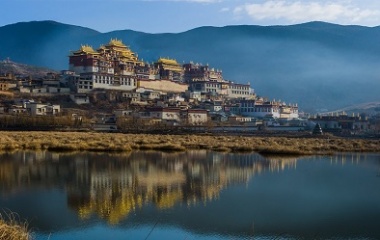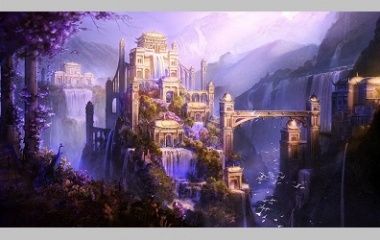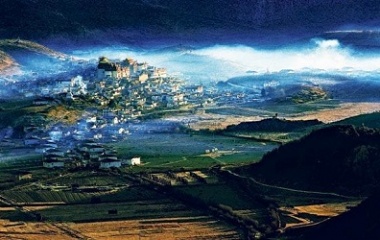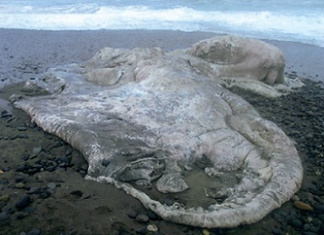The perpetual search for a place free from suffering, and that is home to wisdom, kindness and harmony with nature and other humans, has captured the minds of philosophers, mystics, travelers and spiritualists for hundreds of years.
What Is Shangri-La?
Shangri-La is a mythical utopian village located deep in the unexplored regions of the Himalayan Mountains. Though the term originated in the 1930s, the concept is very similar to ancient paradises such as Shambhala and the Garden of Eden. The inhabitants are said to practice traditional Buddhist ways, free of materialism and other Western influences, live for hundreds of years, and exist in harmony with nature. Within the range of high peaks, the well-hidden village has a sacred palace and lake, according to sources.
Source
The term Shangri-La is based on the novel Lost Horizon by James Hilton, published in 1933. The story is perhaps drawn from the ancient Tibetan myth of Shambhala. It was in the 1580s, however, that the Western world first heard mention of the Shambhala or Shangri-La type paradise. European travelers at the time were received at the court of Emperor Akbar and heard all about the mythical utopia.
Location
Sources reveal the paradise may be located in the Kunlun Mountains, one of the longest mountain ranges in Asia. In the Jin Dynasty, 265 to 420 BC, the Chinese poet Tao Yuanming mentions a place similar to Shangri-La. In his story, a fisherman accidently discovers a group of people living in an isolated, lush area after his boat passes under a mysterious grotto. The villagers were kind, and welcomed the fisherman into their blissful home. In 2001, the area was even renamed Shangri-La to draw more tourists to the location.
Authors also purport the Hunza Valley as being another possible site of the paradise. It was allegedly the basis for Hilton’s book, but since there is no Tibetan influence in the area, it is a less likely candidate. In the 1920s and 30s, a National Geographic journalist lived in the Yunman Province region in China and submitted articles and photographs of the lush valley. This may also have been another potential Shangri-La, according to some sources.
Lost Horizon
In Hilton’s novel, the hidden Shangri-La is a lamasery headed by a 200-year-old monk, and is allegedly situated in the Kunlun Mountains. The inhabitants lived a peaceful life, free of money or greed, and held the secrets to their ancient culture. The novel may have become popular due to the effects of the Great Depression, by providing a means of hope and escape to its readers. A copy of the book could even be found at Camp David at the time, according to some insiders.
Shambhala
Stories of lost, mythical kingdoms have been around since long before Lost Horizon. For hundreds of years, tales have existed in the Buddhist teachings of a place in the Himalayas where the most sacred teachings of the Buddhists are preserved. It is believed to be more a spiritual, rather than physical, location and is known as Shambhala.
Agharti
Agharti, or Agharta, is a legend, similar to the hollow earth theory, of a hidden underground city situated in the Himalayas. Alexandre Saint-Yves d’Alveydre, a French occultist, wrote about Agharta. The mythical kingdom was believed to have very advanced technology. Madame Blavatsky, a renowned Theosophist, then took the story further, claiming one could reach Shambhala through the Agharta tunnels.
Modern References
Shangri-La is the name of a dark section of Saturn’s moon, Titan, which is filled with liquid hydrocarbons. It is said to be another sign of the similarity of Titan and Earth and perhaps provides hope of a Shangri-La outside of our own planet!
After the acclaim of Hilton’s novel, a movie was made with the same name, and was a major hit in 1937. In recent movies, the theme has also been utilized; for instance, in Sky Captain and the World of Tomorrow the characters awaken to find themselves in Shangri-La. Numerous TV series have utilized the concept of the hidden paradise, as well as various books and songs.
The word utopia is derived from Latin and means no place. This is an essential element of a utopia, Shambhala, Eden or Shangri-La. If it could be found, it would likely be flooded with visitors and lose its essential utopian qualities. Perhaps, as many eastern philosophies purport, we can only truly find these idyllic places within ourselves.










